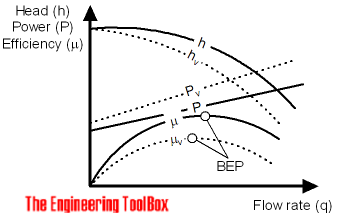Centrifugal Pumps - Influence of Viscosity
Hydrodynamic losses through pumps depends on fluid viscosities.
When a more viscous fluid is handled by a centrifugal pump
- brake horsepower requirement increases
- the head generated is reduced
- capacity is reduced
- efficiency of pump is reduced and the Best Efficiency Point - BEP - is moved

The head, flow and capacity with fluids with other viscosities than used in the original documentation can be modified with coefficients.
Flow
qv = cq q (1)
where
qv = flow compensated for viscosity (m3/h, gpm)
cq = viscosity flow coefficient
q = original flow according pump curve (m3/h, gpm)
Head
hv = ch h (2)
where
hv = head compensated for viscosity (m, ft)
ch = viscosity head coefficient
h = original head according pump curve (m, ft)
Efficiency
μv = cμ μ (3)
where
μv = effciency compensated for viscosity
cμ = viscosity efficiency coefficient
μ = original efficiency according pump curve
Power - SI units
Pv = qv hv ρv g / (3.6×106 μv) (4)
where
Pv = power compensated for viscosity (kW)
ρv = density of viscous fluid (kg/m3)
g = acceleration of gravity (9.81 m/s2)
Power - Imperial units
Pv = qv hv SG / (3960 μv) (5)
where
Pv = power compensated for viscosity (bhp)
SG = specific gravity of viscous fluid



